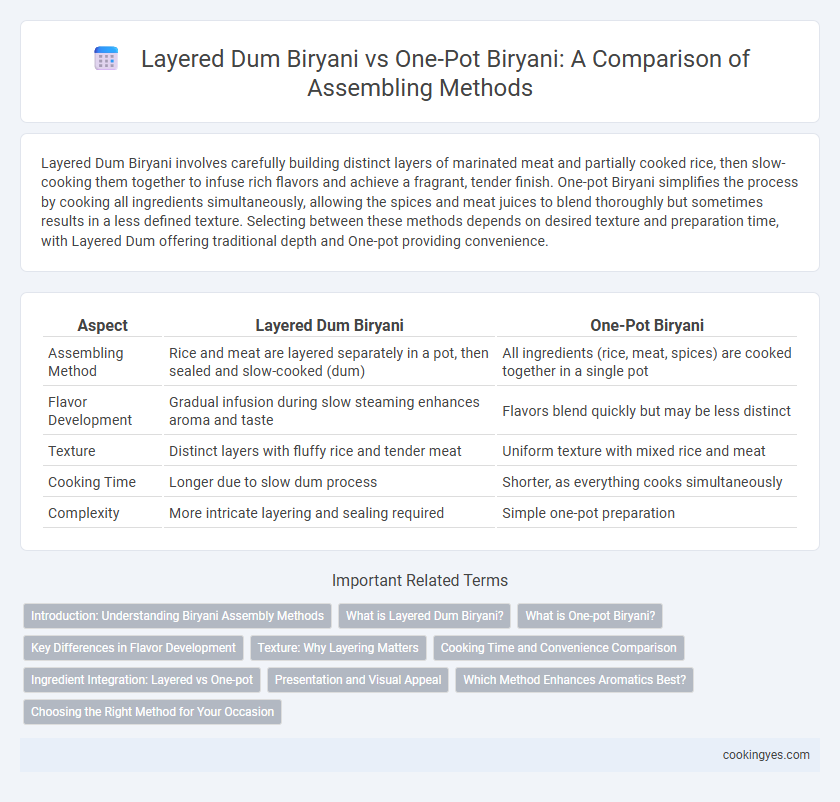Layered Dum Biryani involves carefully building distinct layers of marinated meat and partially cooked rice, then slow-cooking them together to infuse rich flavors and achieve a fragrant, tender finish. One-pot Biryani simplifies the process by cooking all ingredients simultaneously, allowing the spices and meat juices to blend thoroughly but sometimes results in a less defined texture. Selecting between these methods depends on desired texture and preparation time, with Layered Dum offering traditional depth and One-pot providing convenience.
Table of Comparison
| Aspect | Layered Dum Biryani | One-Pot Biryani |
|---|---|---|
| Assembling Method | Rice and meat are layered separately in a pot, then sealed and slow-cooked (dum) | All ingredients (rice, meat, spices) are cooked together in a single pot |
| Flavor Development | Gradual infusion during slow steaming enhances aroma and taste | Flavors blend quickly but may be less distinct |
| Texture | Distinct layers with fluffy rice and tender meat | Uniform texture with mixed rice and meat |
| Cooking Time | Longer due to slow dum process | Shorter, as everything cooks simultaneously |
| Complexity | More intricate layering and sealing required | Simple one-pot preparation |
Introduction: Understanding Biryani Assembly Methods
Layered Dum Biryani assembles marinated meat and partially cooked rice in distinct layers, allowing the flavors to infuse during slow cooking under a sealed lid. One-pot Biryani combines all ingredients simultaneously, offering a quicker method but with less separation of textures and flavors. The choice between these assembly methods significantly impacts the aroma, taste, and presentation of the final dish.
What is Layered Dum Biryani?
Layered Dum Biryani is a traditional cooking method where partially cooked rice and marinated meat or vegetables are arranged in alternate layers, then sealed and slow-cooked in a sealed pot to allow flavors to meld. This technique uses the dum cooking process, which traps steam and infuses the dish with aromatic spices and herbs. The result is a rich, textured biryani with distinct layers that retain individual flavors and moisture.
What is One-pot Biryani?
One-pot biryani is a streamlined cooking method where all ingredients--marinated meat, rice, and spices--are combined in a single vessel and cooked together, allowing flavors to meld seamlessly. This technique contrasts with layered dum biryani, as it eliminates the need for separate steaming steps, resulting in a quicker preparation time without compromising taste. Popular in home kitchens, one-pot biryani offers convenience with rich, aromatic results by infusing spices directly into the dish during the cooking process.
Key Differences in Flavor Development
Layered Dum Biryani enhances flavor development through slow steaming, allowing spices and marinated meat to infuse deeply into each rice layer, creating distinct, rich taste profiles. One-pot Biryani combines all ingredients simultaneously, resulting in a more homogenous flavor with less pronounced layer distinction. The controlled heat distribution in Dum cooking preserves moisture and intensifies aromatic complexity, making the taste more nuanced compared to the quicker, merged flavors of the one-pot method.
Texture: Why Layering Matters
Layered Dum biryani delivers a distinct texture by allowing each layer of marinated meat and partially cooked rice to steam slowly, preserving moisture and enhancing flavor separation. The method ensures that the rice remains fluffy and grains stay separate, while the meat becomes tender and infused with aromatic spices. In contrast, one-pot biryani methods often result in a more homogenized texture, where flavors blend but distinct layers and the desired fluffiness may be compromised.
Cooking Time and Convenience Comparison
Layered Dum Biryani requires longer cooking time due to its slow steaming process that allows flavors to meld deeply. One-pot Biryani offers greater convenience, combining all ingredients in a single vessel for a quicker, less labor-intensive preparation. The choice between the two methods hinges on balancing patience for rich taste against the need for speed and simplicity.
Ingredient Integration: Layered vs One-pot
Layered dum biryani features distinct, carefully arranged layers of marinated meat and partially cooked rice, allowing flavors to meld slowly under steam, preserving the texture and integrity of each ingredient. One-pot biryani combines all ingredients from the start, resulting in a more homogenous flavor profile but often sacrificing the individual texture and visual layering. Ingredient integration in layered dum biryani highlights the gradual infusion of spices and aromas, while one-pot biryani emphasizes convenience and a uniform taste.
Presentation and Visual Appeal
Layered Dum Biryani showcases distinct, vibrant layers of marinated meat and fragrant rice, creating an impressive visual contrast that enhances presentation and heightens anticipation before serving. The slow-cooking technique seals in steam, preserving the structure and ensuring each layer remains separate and visually appealing on the plate. In contrast, One-pot Biryani blends ingredients more thoroughly, resulting in a harmonious yet less compartmentalized appearance that emphasizes uniformity over layered aesthetics.
Which Method Enhances Aromatics Best?
Layered Dum Biryani involves meticulously stacking parboiled rice and marinated meat, then cooking them slowly in a sealed pot, which traps steam and intensifies the infusion of saffron, cardamom, and other aromatic spices. The one-pot biryani method combines all ingredients in a single vessel, resulting in a quicker cooking process but with less pronounced layers of fragrance. For maximum aroma enhancement, the slow steam-cooking technique in Layered Dum Biryani allows deeper permeation of essential oils, creating a more flavorful and aromatic dish.
Choosing the Right Method for Your Occasion
Layered Dum Biryani requires meticulous layering of par-cooked rice and marinated meat, ideal for festive occasions demanding rich flavors and intricate presentation. One-pot Biryani combines all ingredients in a single vessel, making it suitable for casual gatherings and quick preparation without compromising on taste. Selecting between these methods depends on the event's scale, available time, and desired complexity of the final dish.
Layered Dum vs One-pot Biryani for assembling method Infographic

 cookingyes.com
cookingyes.com